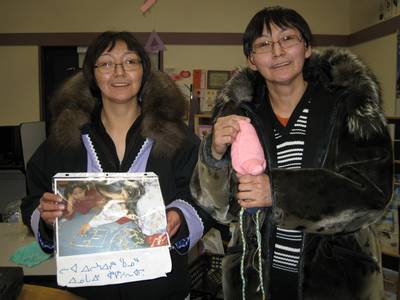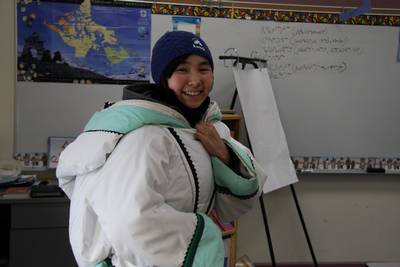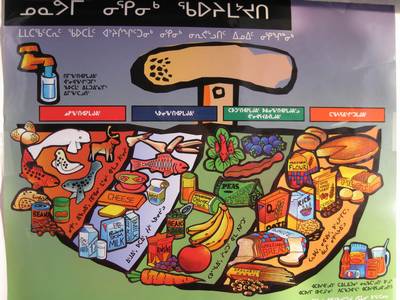10 Mar, 2008
Women's Power
I was surprised to see so many women hunters since I came to Nunavut. Traditionally, hunting used to be a men's job, but I was told, during the hard time in 1960s, more women started involved in hunting. Being more patient and brave than man sometimes, quite a few women were famed as best hunters. In HTAs (Hunters and Trappers Associations) of both Resolute and Grise Fiord, the heads were women.
Mika was a women hunter who is capable of going out by herself. There is a big difference between someone who is capable of go hunting alone and someone who is not. To be capable of hunting alone, you have to know everything.
Otherwise, not only you don't catch anything, but you can kill yourself. She was outspoken and caring, and told me when we met for the first time that my way of wearing a parka's hood was dead wrong. She said, 'people will look at you as a lazy person or ignorant'.

The left is her sister Teevai and right is Mika. They look very much alike.
Showing me a lot of pictures, she told me about many fun things about Grise Fiord in summer time. A polar bear swimming right beside the boat, first time when her son shot a bird, a baby bird who was so attached to her thinking her as mother. She said, as she is so fond of taking pictures and gets excited with things, people would get tired of her asking to stop the boat every time she saw something nice to photograph.
Mika who is a teacher of Inuktitut and at the same time the sub-mayor of Grise Fiord, seems to be right in between old and new generations. Her grand mother spoke only Inuktitut, and ate only Inuit's traditional food (but liked coke very much). Her mother, however, although raised with Inuit's traditions, wisdom and skills, watched TV, baked banik. Mika's oldest sister started speaking English. And Mika herself , while she hunts, knows how to make traditional costumes, and loves Inuit's food, also enjoys modern culture. Her twenty eight year-old daughter uses computers at ease, bakes bread and cookies and enjoy fishing and camping. As it comes to her nineteen year-old daughter, she loves on-line chatting, and talking on the phone, and interested in fashions, but goes hunting when there is a chance. And her seven year-old grand daughter reads English well, and finds out about anything in internet, she says. She also says that biggest things they learned from white people were the discipline and food culture.

Dressed in 'Amaut', Mika's daughter, Lisa, takes care of her niece.
I asked Mika what she thinks it means to preserve the Inuit's tradition in this time of change.
"Last year, I saw a tern's chicks hatching in September. Usually they are born in July and learn how to fly before they leave for south. If they hatch in September, they would freeze to death before they could fly. We don't know how the climate will change from now on. Animals and the man would not survive if they cannot adapt to the change of environment. Therefore, we have to be prepared. Inuits should not loose their wisdom and skills to survive that have been inherited from our ancestors, for we do not know when we would have to live with seal oil lamps again.

[ Ullu ] Figure explaining a new way of 'eating well'. Note the food drawn here. From the group of left to right; 'for strong mussels', 'for strong bones and teeth', 'for healthy eyes, skins and immune system' and 'for energy'. Mika added, although the beluga whale is grouped in the farthest left, it should be in green group as its skin is rich in vitamins and minerals. Eating well, how to cook, how to shop foods are important things to teach in school, she said.
Noriko Miyashita
 HOME
HOME